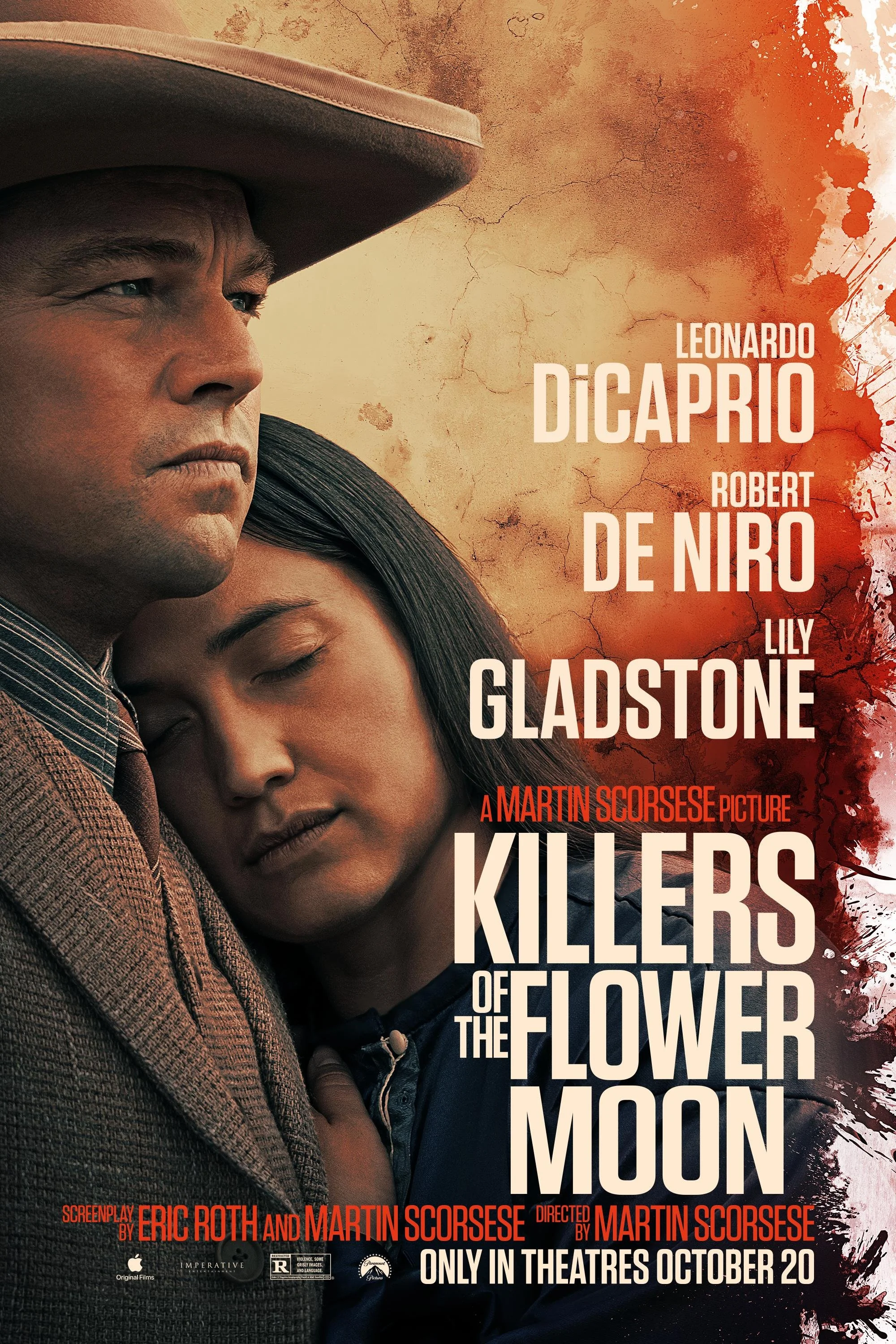Killers of the Flower Moon Review
Martin Scorsese has had an illustrious, near sixty-year career with an immensely varied filmography. His work has inspired acclaimed directors such as Bong Joon-Ho, Paul Thomas Anderson, Lynne Ramsay and many more. His passion for cinema reaches beyond his own films as he endorses new talent, having helped to save Turner Classic Movies, and used his status to support foreign cinema; there is a reason he has been labelled the godfather of cinema. Now at eighty-years old, Scorsese has returned to the big screen to deliver his twenty-fifth feature film.
Adapted from the Non-fiction novel by David Grann, Killers of the Flower Moon opens in 1897 with the native American tribe, the Osage, grieving over the loss of their natural way of life. Their community is being assimilated by white, industrial America and have now been given a small, barren area of land in Oklahoma in which to settle. However, what was deemed worthless by the US government is anything but, for oil has been struck. The Osage are now not only the richest people in America - but the world. Now in 1918, with their expanded town, big houses and fast cars, the Osage lay prey to evil from avenues they could never have anticipated. With the news of such vast wealth, Ernest Burkhart (Leonardo DiCaprio) soon arrives, returning from the first world war and looking to find work with his uncle, William Hale (Robert De Niro), a wealthy rancher and beloved member of the community. He quickly finds a job as a driver to Mollie Kyle (Lily Gladstone) one of the wealthiest Osage members. With everything now in place, William Hale, with his watchful eyes, initiates a plan of unspeakable horror.
Coming in at three hours and twenty-six minutes, Killers of the Flower Moon is an epic in both scope and runtime with every second of it being deserved, with not one scene feeling unnecessary or protracted. Killers of the Flower Moon is his scathing indictment of America and the bloodshed it was built on; how a racial genocide went practically unpunished and the importance of remembering such history. At its core, this is a film is about the true face of evil. How in the presence of evil, those that commit such atrocities believe their cause just, and deem themselves innocent which is where the film’s true horror lies. Scorsese frames Hale and Ernest’s actions as ordinary, banal almost, and with every passing scene the weight of their actions become increasingly harder to bear. Scenes of violence and discussions over their next victims, are depicted in such a nonchalant manner that it makes it all the more despicably sickening.
Lily Gladstone provides an exceptionally tragic performance as Mollie, emblematising the slaughter and diminishment of the Osage people as she grows weaker throughout. Mollie’s life is embellished in pain and Gladstone delivers immensely, giving one of the best performances this year. Leonardo DiCaprio has been given the most challenging role of his entire career as Ernest. He is no charismatic fiend like Jordan Belford, or an over-the-top maniac like Calvin Candy, this is a different breed of sinister, a fool without morals or the emotional intelligence to distinguish what true love means. DiCaprio morphs into this pitiful creature, complete with a concrete grimace to meet this monumental challenge, in turn delivering a career best performance. De Niro completely slips away under the villainous guise of William Hale. His performance is understated, calm and even jovial at points, but still commands power over everyone he comes across. Hale’s capacity for evil, with De Niro’s excellent performance, makes him one of the great villains of the 21st century. The ensemble here is vast and with his casting directors Ellen Lewis and Rene Haynes, Scorsese has put together an astounding mix of character actors and Osage men and women that enrich the film even further.
Scorsese has once again teamed up with cinematographer Rodrigo Prieto (The Irishman, Silence) who brings scale and a rich colour palette to the screen. The images are striking, with the ranch fire sequence being a truly mesmerising sequence. Thelma Schoonmaker returns as Scorsese’s long-time editor and utilises her skills to astounding effect. Her ability to instantly change the film’s mood and create juxtaposing, jarring scenes hit like a sucker punch. Composer Robbie Robertson sadly passed away earlier this year, making this his final score. However, his score is rustic and stripped back, allowing the performances to really breathe, but providing the right atmosphere in every moment.
Killers of the Flower Moon is a rich tapestry of a film. One that encompasses a multitude of ideas and shines a light on one of America’s darkest and most shameful chapters. Where The Irishman was a statement on Scorsese’s life as a filmmaker and his mortality; Killers of the Flower Moon is his final statement on America’s true nature: ugly, violent, and greedy. Its subject matter is uncomfortably relevant, shining a light on mankind’s lack of self-reflection, as one character puts it, “This is just another tragedy. People will forget and no one will care.” Every aspect of filmmaking is masterfully handled and Scorsese triumphs with yet another profound and unforgettable ending. After twenty-five films, Killers of the Flower Moon may stand as Scorsese’s final film, but also the most important he has ever made.
